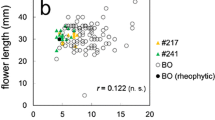Abstract
Many plant species are miniaturized in the alpine region in Yakushima, Japan. To examine how these alpine dwarf plants are different from their related lowland ones of the same species, we analyzed two phylogenetically distinct species cytologically, genetically and morphologically: one is a fern species, Blechnum niponicum, and the other is an angiosperm species, Lysimachia japonica. The analysis shows that the alpine dwarf and the lowland plants in each of these species do not differ in chromosome number or genetic constitution. The organ-level comparison between the alpine dwarf and lowland plants of B. niponicum shows that the fertile leaf size correlates closely with the sterile one. By contrast, the flower size does not correlate with the leaf size in L. japonica. At the cell level, the leaf size of the alpine dwarf plants of B. niponicum consists of a smaller number of epidermal cells than that of the lowland plants of this species. On the other hand, the smaller leaf size of the alpine dwarf plants of L. japonica depends on both the smaller number and the smaller size of the epidermal cells. We conclude that plant dwarfism in Yakushima shows variation at both the organ and cell levels.








Similar content being viewed by others
References
Fujishima H, Okada H, Horio Y, Yahara T (1990) The cytotaxonomy and origin of Ranunculus yaegatakensis, an endemic taxon of Yakushima island. Bot Mag Tokyo 103:49–56
Hatsushima S (1991) Flora of the northern Ryukyus. Asahiinsatsushoseki, Kagoshima
Imaichi R, Kato M (1992) Comparative leaf development of Osmunda lancea and O. japonica (Osmundaceae): heterochronic origin of rheophytic stenophylly. Bot Mag Tokyo 105:199–213
Kato T (1990) Taxonomical studies on the Hypericum pseudopetiolatum complex 4. J Fac Sci Imp Univ Tokyo 3(17):341–368
Kato M, Imaichi R (1991) Leaf anatomy of tropical fern rheophytes, with its evolutionary and ecological implications. Can J Bot 70:165–174
Körner C (1999) Cell division and tissue formation. In: Körner C (ed) Alpine plant life: functional plant ecology of high mountain ecosystems. Springer, Berlin Heidelberg New York, pp 235–245
Körner C, Larcher W (1988) Plant life in cold climates. In: Long SP, Woodward FI (eds) Plants and temperature. S. E. B. Series 42. The Company of Biologists, Cambridge, pp 25–57
Körner C, Menendez-Riedl SP (1989) The significance of developmental aspects in plant growth analysis. In: Lambers H, Cambridge ML, Konings H, Pons TL (eds) Causes and consequences of variation in growth rate and productivity of higher plants. SPB Academic Publishers, Hague, pp 141–157
Körner C, Bannister P, Mark AF (1986) Altitudinal variation in stomatal conductance, nitrogen content and leaf anatomy in different plant life forms in New Zealand. Oecologia 69:577–588
Körner C, Neumayer M, Scheel-Smeets J, Menendez-Riedl SP (1989a) Functional morphology of mountain plants. Flora 182:353–383
Körner C, Menendez-Riedl SP, John PCL (1989b) Why are bonsai plants small? A consideration of cell size. Aust J Plant Physiol 16:443–448
Levan A (1939) Tetraploidy and octoploidy induced by colchichine in diploid Petunia. Hereditas 25:109–131
Lewis WH (1980) Polyploidy in species populations. In: Lewis WH (eds) Polyploidy. Plenum, New York, pp 103–144
Masamune G (1929) A preliminary report on the vegetation of the island of Yakushima. Kagosima
Müntzing A (1936) The evolutionary significance of autopolyloidy. Hereditas 21:263–378
Nei M (1972) Genetic distance between populations. Am Nat 106:283–292
Paul EMM (1984) The response to temperature of leaf area in tomato genotypes. I. Cell size and number in relation to the area of a leaf. Euphytica 33:347–354
Richardson BJ, Baverstock PR, Adams M (1986) Allozyme electrophoresis. Academic, New York
Shiraishi S (1988) Inheritance of isozyme variations in Japanese black pine, Pinus thunbergii Parl. Silvaec Genet 37:93–93
Smith HH (1939) The induction of polyploidy in Nicotiana species and species hybrids by treatment with colchichine. J Hered 30:291–306
Tagawa M (1938) Miscellaneous notes on the East-Asiatic pteridophytes with special reference to the Japanese species (7). J Jpn Bot 14:705–712
Takamiya M (1993) Chromosome numbers of Woodsia kitadakensis and W. subcordata (Woodsiaceae). J Jpn Bot 68:73–76
Tsukaya H (2002a) Interpretation of mutants in leaf morphology: genetic evidence for a compensatory system in leaf morphogenesis that provides a new link between cell and organismal theories. Int Rev Cytol 217:1–39
Tsukaya H (2002b) Leaf anatomy of a rheophyte, Dendranthema yoshinaganthum (Asteraceae), and of hybrids between D. yoshinaganthum and a closely related non-rheophyte, D. indicum. J Plant Res 115:329–333
Tsukaya H (2005) Molecular variation of Spiranthes sinensis (Orchidaceae) in Japan, with special reference to systematic treatment of seasonally differentiated groups and a dwarf form, f. gracilis, from Yakushima Island. J Plant Res 118:13–18
Usukura M, Imaichi R, Kato M (1994) Leaf morphology of a facultative rheophyte, Farfugium japonicum var. luchuense (Compositae). J Plant Res 107:263–267
Van Steenis CGGJ (1981) Rheophytes of the world. Sijthoff and Noordhoff, Alpena an den Rijn
Yokoyama J, Fukuda T, Tsukaya H (2003) Morphological and molecular variation in Mitchella undulate, with special reference to the systematic treatment of the dwarf form from Yakushima. J Plant Res 116:309–315
Acknowledgements
The authors would like to thank Dr. Akihiro Seo (Kyoto University, Japan), Ms. Keiko Iida, Mr. Masayuki Kojima, Ms. Sizuka Tsuneki and Ms. Yoshiko Nakajima for their kind help, especially in our field collection of the plant samples, and Dr. Hirokazu Tsukaya (National Institute for Basic Biology, Japan) for his valuable advice regarding the discussion part in the present study. This study was financially supported by Grant-in-Aid No. 15370037 and No. 16405014 provided by the Japan Society for the Promotion of Science to NM, and also by a Grant-in-Aid for the 21st Century COE Program (A2, Kyoto University).
Author information
Authors and Affiliations
Corresponding author
Rights and permissions
About this article
Cite this article
Shinohara, W., Murakami, N. How have the alpine dwarf plants in Yakushima been miniaturized? A comparative study of two alpine dwarf species in Yakushima, Blechnum niponicum (Blechnaceae) and Lysimachia japonica (Primulaceae). J Plant Res 119, 571–580 (2006). https://doi.org/10.1007/s10265-006-0016-5
Received:
Accepted:
Published:
Issue Date:
DOI: https://doi.org/10.1007/s10265-006-0016-5




